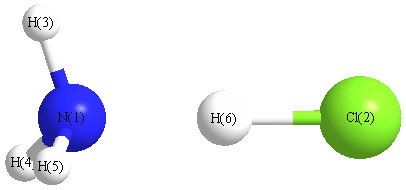Vibrational Frequencies calculated at B2PLYP/6-31G**
| Mode Number |
Symmetry |
Frequency
(cm-1) |
Scaled Frequency
(cm-1) |
IR Intensities
(km mol-1) |
Raman Act
(Å4/u) |
Dep P |
Dep U |
|---|
| 1 |
A1 |
3519 |
3519 |
3.58 |
|
|
|
| 2 |
A1 |
2212 |
2212 |
2071.46 |
|
|
|
| 3 |
A1 |
1167 |
1167 |
105.38 |
|
|
|
| 4 |
A1 |
217 |
217 |
34.65 |
|
|
|
| 5 |
E |
3660 |
3660 |
13.27 |
|
|
|
| 5 |
E |
3660 |
3660 |
13.27 |
|
|
|
| 6 |
E |
1699 |
1699 |
23.62 |
|
|
|
| 6 |
E |
1699 |
1699 |
23.62 |
|
|
|
| 7 |
E |
875 |
875 |
78.40 |
|
|
|
| 7 |
E |
875 |
875 |
78.40 |
|
|
|
| 8 |
E |
275 |
275 |
19.91 |
|
|
|
| 8 |
E |
275 |
275 |
19.91 |
|
|
|
Unscaled Zero Point Vibrational Energy (zpe) 10065.4 cm
-1
Scaled (by 1) Zero Point Vibrational Energy (zpe) 10065.4 cm
-1
See section
III.C.1 List or set vibrational scaling factors
to change the scale factors used here.
See section
III.C.2
Calculate a vibrational scaling factor for a given set of molecules
to determine the least squares best scaling factor.
Charges, Dipole, Quadrupole and Polarizability
Charges from optimized geometry at B2PLYP/6-31G**
Charges (e)
| Number |
Element |
Mulliken |
CHELPG |
AIM |
ESP |
| 1 |
N |
-0.742 |
|
|
|
| 2 |
Cl |
-0.319 |
|
|
|
| 3 |
H |
0.283 |
|
|
|
| 4 |
H |
0.283 |
|
|
|
| 5 |
H |
0.283 |
|
|
|
| 6 |
H |
0.211 |
|
|
|
Electric dipole moments
Electric dipole components in Debye
(What's a Debye? See section
VII.A.3)
| |
x |
y |
z |
Total |
| |
0.000 |
0.000 |
-5.344 |
5.344 |
| CHELPG |
|
|
|
|
| AIM |
|
|
|
|
| ESP |
|
|
|
|
Electric Quadrupole moment
Quadrupole components in D Å
| Primitive |
|---|
| | x | y | z |
|---|
| x |
-20.034 |
0.000 |
0.000 |
| y |
0.000 |
-20.034 |
0.000 |
| z |
0.000 |
0.000 |
-14.567 |
|
| Traceless |
|---|
| | x | y | z |
|---|
| x |
-2.733 |
0.000 |
0.000 |
| y |
0.000 |
-2.733 |
0.000 |
| z |
0.000 |
0.000 |
5.466 |
|
| Polar |
|---|
| 3z2-r2 | 10.933 |
|---|
| x2-y2 | 0.000 |
|---|
| xy | 0.000 |
|---|
| xz | 0.000 |
|---|
| yz | 0.000 |
|---|
|
Polarizabilities
Components of the polarizability tensor.
Units are
Å
3 (Angstrom cubed)
Change units.
| |
x |
y |
z |
| x |
2.255 |
0.000 |
0.000 |
| y |
0.000 |
2.255 |
0.000 |
| z |
0.000 |
0.000 |
4.423 |
<r2> (average value of r
2) Å
2
| <r2> |
77.406 |
| (<r2>)1/2 |
8.798 |
